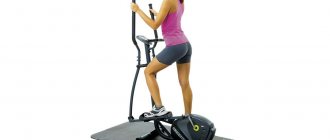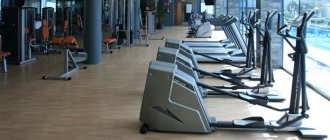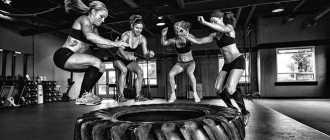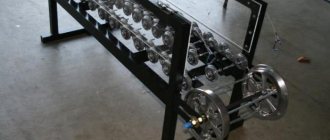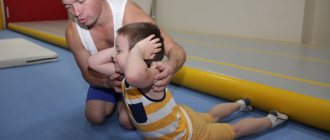Benefits and contraindications
Doing exercises on a ski machine not only helps you lose weight and tone your figure, but also improve your health. Among the beneficial effects on the body of the practitioner, the following can be noted:
- Improving the functioning of the heart muscle;
- Reducing the impact of stress and strengthening the immune system;
- Increasing the elasticity of blood vessels and normalizing metabolism;
- Removing toxins and relieving swelling.
It should be noted that the load on the calf joints is minimal - this allows the exercise machine to be used by people of advanced age. Of course, you will need to take into account existing contraindications, after consulting with your doctor.
It is not advisable to perform such training in the following cases:
The creators and builders of SK KANT were alpine skiing lovers and enthusiasts Arievich Grigory Eleozarovich and Vinogradov Daniil Daniilovich. In the early 80s, they decided to organize a ski slope and a winter sports club in Moscow, which later received the official name “KANT”. GE and DD.jpg The history of the creation of the KANT sports complex began in 1982, when an initiative group led by G.E. Arievich. organized the ski resort "Nagornaya".
Having received the territory in the floodplain of the Kotlovka River, the initiative group began to improve the territory, slopes were raised and filled, access roads were paved and highways were built. In 1990, the initiative group was transformed into MP "KANT" and then into LLC "SK KANT". In 1992, the KANT sports club was granted a long-term lease of a land plot of 0.8 hectares in the floodplain of the Kotlovka River with the condition of improving the surrounding area of 59 hectares. In 1998, SK KANT and the Nagornaya Administration organized an autonomous non-profit organization, the Nagornaya Children's Youth Sports School, to operate the sports complex.
The ski simulator belongs to the category of cardio equipment. With the help of physical exercises, you can strengthen the cardiovascular and respiratory systems, get rid of excess weight, increase endurance and get rid of shortness of breath. With systematic training, you can create a slim and toned body, and constantly keep your muscles in good shape.
One of the main benefits of training on a ski simulator is the use of all major muscles at the same time. Due to its complex effect on the body, it allows you to quickly lose excess weight, and its affordable price will allow you to purchase it for home use and eliminate the need to visit the gym.
The presence of smooth, cyclical and slow movements during training on a ski simulator minimizes the presence of contraindications to such a training process.
What muscle groups are involved?
During training on a ski simulator for home, muscle mass does not grow. But this process leads to the burning of subcutaneous fat, as well as increased muscle tone. Movements on the simulator involve the main muscle groups:
- gluteal;
- cardiac;
- calf;
- hamstrings;
- chest;
- dorsal;
- biceps;
- triceps, etc.
Slow movements, simulating walking on a ski track, force the upper and lower parts of the body to work. This saves time and increases the effectiveness of your training.
How to practice
- Before starting training on a ski simulator, you should eat a vegetable salad half an hour before and under no circumstances start training on an empty stomach.
- It is necessary to do a light warm-up, warming up and stretching the main muscle groups.
- When figuring out how to properly practice skiing on simulators, the main thing is to learn one rule for the correct placement of your legs, slightly bent at the knee joints, on the platforms.
- By placing your feet on the machine, make sure that your entire foot is on the surface. Take the sticks with your hands and, having set the appropriate load mode, move your arms and legs back and forth.
- Mandatory calculation and control of training heart rate.
- When performing exercises, consider moderation and gradual increase in load.
- Breathing is calm and measured. Inhale with effort, exhale with relaxation. Holding your breath is not allowed, since then the process of enriching the body and muscle tissue with oxygen is suspended.
- To lose weight, it is recommended to exercise with a slight load, but at a fairly increased pace.
Body positions during training on the ski simulator:
- The main position is a straight back, the head does not fall down, and the gaze is directed forward.
- All groups of muscle bundles are involved.
- Reverse movements are carried out correctly if the knee joints bend as much as possible.
- The gluteal muscles and hamstrings are worked.
- Training the muscle fibers of the thigh and calf muscles is carried out by tilting the body forward.
- Stretching the hamstrings and training the buttocks occurs when exercising on a machine when the body is tilted back and the body position is as close as possible to a sitting position.
A properly developed training plan, setting the intensity of the exercises and their duration, will allow you to tighten your muscles in a fairly short time. The period of the training process to improve health and maintain body shape is 30-40 minutes 3 times a week. And if the main goal of the exercise is to fight excess weight, you will have to work for 60 minutes 5 times in seven days.
Everyone has known about the usefulness of skiing since school days, but the possibility of such activities is limited by weather conditions. For lovers of this type of exercise, a weight loss simulator has been developed - skiing.
You need to choose a ski simulator for weight loss based on your physical needs and abilities.
If you are purchasing mechanical skis for yourself, you should take into account the height and weight for which the machine is designed, as well as take into account the stride length. In order not to be mistaken with the brand, pay attention to reviews
Related
On such a weight loss simulator, movements are carried out voluntarily, so exercising on it is safe. True, training is not much like skiing, except for the load on the same muscle groups.
Unrelated
A trainer with a disconnected system gives a person a sensation that simulates the walking of skiers. The legs move independently of each other, the sticks are replaced by cables. More muscles are used, therefore, a non-connected exercise machine is more useful for weight loss.
It needs to be monitored, the load on the arms and legs adjusted, and maintained in working condition.
There is another classification of simulators on sale, which includes 3 types:
- Home;
- Semi-professional;
- Professional.
A ski simulator designed for use at home is compact, often has a folding design, is lightweight and is not suitable for daily training, unlike a professional one. The latter are not so convenient, have large dimensions, and are problematic to maintain at home, but they are able to cope with intense loads and are suitable for training in gyms.
Positive sides:
- When training, the upper and lower muscles of the body are included in the work;
- The ski simulator burns about 700 calories over an hour of intense exercise;
- The load level is easily changed;
- Easy to use;
- You can exercise for people suffering.
- The simulator requires constant maintenance;
- Price;
- Bulky;
- Difficult to find in stores.
Ski simulators
Ski simulators
The ski simulator is designed to teach skiing techniques. It’s not suitable for training already experienced skiers, but putting a beginner on the ski track is fine.
Cost from 30 thousand rubles.
Virtual ski simulator Representative models: SkyTechVR, Russian development Skytec, Sky Tec Leader Pro.
One of the most important questions from readers is what are the names of the simulators that allow you to train like skiing. Most likely this question applies to several popular ski simulators:
This device simulates maximum presence on the ski slope, even though at this time the person is in a specially prepared room.
Using a movable system of skis (or a snowboard), the student can reproduce all the basic movements corresponding to the descent from the mountain, and large screens are installed in front of his eyes, complementing the picture with mountain landscapes or views of the Olympic slopes.
What can be worked out?
- Start learning to descend not with the traditional “plow” technique, but immediately with parallel skiing;
- Learning the basics of carving riding (cut arcs);
- Obtaining the skill of edging skis - a special angle of inclination in the knee joint and hip joint, the purpose of which is to place the ski on the edges (lateral edge).
A similar ski simulator costs from 1,300,000 rubles. Half an hour of training in a specialized club - 1,500 rubles.
Analysis of the exercise
What muscles work
For cardio exercise, it is usually considered incorrect to describe working muscle groups and so on. However, in the case of a moving staircase, an exception is made. After all, the buttocks and thighs are worked out perfectly on it.
- The main muscles worked are the gluteals, hamstrings, and calves;
- Auxiliary muscles: core muscles, soleus muscles, back muscles.
pros
- Strengthens the heart and blood vessels;
- Helps normalize metabolism;
- Corrects physical inactivity;
- Helps strengthen the muscles of the legs and buttocks for those who do not strive for strength training;
- Helps get rid of routine in training programs;
- Suitable for fitness bikini training and specialization in the development of gluteal muscles;
- Can be used at home:
- Replaces impact types of exercise, such as running and jumping;
- Allows you to significantly increase calorie consumption;
- Increases the energy intensity of any exercise;
- Suitable for high-intensity interval training
Preparing for the exercise
In cardio training, the main thing is to choose an adequate mode that would suit your training goals. If the goal is to burn excess fat or recover, the workout should not exceed an hour in time. For those who want to preserve muscle and improve physical condition during cardio training, intervals are suitable. They can't last more than 20 minutes and still be very effective; Before starting training, you should perform joint exercises
It is not enough to just warm up your knees and ankles; you need to pay attention to your shoulders, elbows, and wrists. 8-9 rotations are enough; Training should begin in a low heart rate zone, usually no higher than 40 percent of maximum; Warm-up lasts 5-10 minutes, the transition to working intensity should be smooth, the body should work into the load; The goal of warming up on a moving staircase is to gradually increase your heart rate.
Therefore, for effective work it is necessary to monitor the pulse and accelerate it slowly. Warm-up on a moving staircase occurs at a slow pace, but with the same step height; Only the main part of the workout is carried out at the working pulse; the cool-down is also carried out at a low pulse. The purpose of the cool-down is to calm the heart.
Execution Rules
- Walking without support is the most energy-intensive way to cope with this type of load. This type of walking on a stepper is extremely useful and implies an optimal load. If a person slightly holds on to the handles, it is not scary;
- The biomechanics of working with the hands resembles the movements during running, the hands move along the body, they are quite relaxed, and do not help, but do not interfere with the movement;
- The knees should not be inserted, the ankles should not be overstrained due to sudden straightening;
- The range of movement should remain natural. The step is performed in the same way as in ordinary life. You should work with slightly pointed toes, soft ankles and knees;
- The legs do not straighten completely, even if you step over a step. It is worth abandoning the forced increase in the amplitude of movement if it is not possible to walk over a step and increase the amplitude of movement;
httpv://www.youtube.com/watch?v=embed/iXXsMuo9HmM
Errors
- Back too bent;
- Heel lifting and toe walking;
- The opposite problem is walking exclusively on your heels;
- Hanging (support) on handrails;
- Stooping, arching in the thoracic and lumbar regions;
Efficiency Tips
- You can load the gluteal muscles by swinging your free leg back after each step;
- Some people use a hip circle for the hips, that is, a circular shock absorber. It should fix the legs in a certain position and make it difficult to step. Due to the shock absorber, you can use the adductor muscles of the thigh more and work the buttocks;
- Some trainers equate sideways and upward steps with a shock absorber to a full buttock workout;
- The resistance level of the machine can be adjusted. Interval loading style varies depending on how the resistance is set. You can make it as large as possible, and due to this, work the muscles of the legs and buttocks more;
- The workout may not be the longest, but the calorie burn will be higher due to the higher level of resistance;
- For aerobic endurance, it is recommended to train at a heart rate of 85% of the maximum heart rate; for weight loss, the heart rate may be lower, but the training should continuously last more than 20 minutes if it is performed at a steady pace.
How to properly exercise on a ski simulator?
If you use a ski simulator, “how to exercise properly to lose weight” is the main question. So, initially you need proper preparation for the lesson. Start from your biories, it’s better to study in the evening, and “larks” will tolerate morning classes better. You cannot exercise earlier than an hour after you wake up, and later than two hours before going to bed.
Start your session with a warm-up to prepare your body for further stress. For five minutes, do squats, bends, and arm swings. For the best effect, you should alternate training on a ski machine with strength exercises.
A proper training program is important. The intensity, regularity and duration of classes is determined by the goals you are pursuing. If you just want to keep fit and improve your health, it is enough to exercise three times a week for half an hour. If you want to lose weight, workouts should be more frequent and longer. You need to exercise for 45-60 minutes 4-5 times a week.
For maximum benefit from your workouts, calculate your training heart rate. If you are a beginner, the average frequency may be 110-120 beats per minute. Further the indicator should increase. The maximum allowable heart rate for cardio training should be determined using the formula 220 minus your age. You will get the fat-burning effect at a heart rate equal to 60-70% of the maximum allowable. It is not necessary to use a heart rate monitor. You can take a stopwatch and measure your pulse for 10 seconds. Multiply the result by 6. This will be your heart rate. In the future, you can train based on your feelings. We offer two training options:
Intense Interval Training
- 10 minutes of moderate exercise, gradually you need to reach a heart rate of 50-60% of the maximum.
- Intervals must be alternated: 4 minutes 50-60% of heart rate and 2 minutes 80%. Repeat five times.
- This is followed by a five-minute cool-down - slow walking, which will help restore your heart rate.
Moderate training to develop endurance
- 40 minutes of exercise at a heart rate of 50-60% of the maximum.
- 10 minutes cool down with easy walking.
Regular exercise on a ski simulator helps you lose weight, pump up your muscles and strengthen your body as a whole. Therefore, if you have the opportunity to buy it for your home, be sure to do so. Thus, you will always have a reliable assistant at your fingertips in the fight against extra pounds. The main thing is not to be lazy and study diligently.
Those who dream of losing weight should try the Ski elliptical trainer for training, which provides simultaneous load on all muscle groups. All that remains is to decide whether to buy a device for home use or go to the gym. It’s a good idea to find out the features of these devices and get acquainted with the ratings of the models.
Example programs
Unfortunately, training on such a simulator is monotonous; you can diversify the activity only by changing the load or pace of movements.
For beginners
- Step frequency – 45 per minute;
- Lesson time – 30 minutes;
- Heart rate condition – 60% of the maximum value.
This class is held 3-4 times a week, suitable for people with health problems or as a cardio warm-up before the main group of exercises.
For intermediate level
- Step frequency – 55 per minute;
- Class time – 45–50 minutes;
- Pulse status – 70%.
Classes are held 4-5 times a week for an unlimited amount of time, this schedule is suitable for people who want to lose weight.
For advanced
- Step frequency – 65 per minute;
- Class time is an hour;
- Pulse status – 85%.
It is recommended to train 5-6 times a week. The program is suitable for athletes who need to keep their cardiovascular system in shape.
THESE ARTICLES WILL HELP YOU LOSE WEIGHT
Your feedback on the article:
( 816 ratings, average: 4.51 out of 5)
Exercises in the gym without a trainer: recommendations for beginners
First of all, you must follow the following rules for training in the gym:
Always start your workout with a warm-up. This will allow you to tone your muscles, warm them up and prepare them for the work ahead. Warm-up is performing simple cardio exercises. This could be running on a treadmill, jumping rope, lunges without weights, jumping, or riding an exercise bike. After warming up, muscles are more pliable and less susceptible to injury. Before the main workout, it is recommended to properly stretch your joints using leisurely rotational movements. Start with the neck, then move to the shoulders, elbows, hands, then knead the torso and spine by bending in different directions
And lastly, work the joints of the legs and lower back. You should exercise directly on the simulators with caution. Don't start with heavy weights if you're a beginner.
During the introductory training session, set the minimum weight values, and only then, when you have confidently mastered the technique, can you gradually increase the load. After completing the main workout, you need to return to the cardio equipment and also do some stretching exercises. This will significantly reduce or completely eliminate muscle pain the day after your workout.
By following these recommendations, you will significantly reduce the risk of injury and increase the effectiveness of each session.
Indications and benefits of a ski simulator
People who want to:
- lose weight;
- increase endurance;
- strengthen the muscle corset;
- stimulate the cardiovascular system;
- dry the fat layer.
Perhaps someone just likes skiing, but skiing without snow is problematic. We have now created virtual ski equipment. You can practice on it all year round and hone your skills.
Benefits from classes:
httpv://www.youtube.com/watch?v=embed/j3cWhfWBFb4
httpv://www.youtube.com/watch?v=embed/j3cWhfWBFb4
In principle, the indications and benefits are the same. We won’t repeat ourselves, but just add a few:
- the back muscles work, which improves posture;
- joints are strengthened;
- metabolism and metabolism improves;
- deep breathing is stimulated, and this is beneficial for the whole body, as more oxygen is supplied;
- blood circulation increases, more nutrients and vitamins reach the tissues;
- combating stress and depression. It has been proven that sport has a positive effect on the nervous system.
What muscles is it designed for?
Working out on a ski simulator is a standard cardio workout that helps increase the tone of all major muscle groups and reduce the amount of subcutaneous fat. Therefore, you should not expect an increase in muscle mass from training on these types of exercise machines. But the secret of such exercises lies in the involvement of many muscle bundles during one action and a significant increase in endurance.
The main muscles that are used during training on the simulator:
- hamstrings;
- quadriceps femoris;
- gluteal muscles;
- triceps muscle of the upper limbs;
- muscles of the upper thoracic region;
- middle muscle bundles of the chest;
- lower pectoral muscles;
- "wings" of the back;
- rhomboid back muscles;
- middle and bottom of trapezoid;
- back extensors;
- abdominal muscle bundles;
- biceps;
- muscles of the shoulder girdle;
- extensor muscles of the shoulder and forearm;
- rear deltoids;
- heart muscle;
- deep core muscles;
- calf muscles.
Elliptical training program for weight loss
To achieve maximum results, you need to exercise regularly. They use simulator skis for weight loss according to the classic training program. It involves a five-minute warm-up at the beginning and a cool-down of the same time at the end. The program includes training by day:
- first – moderate loads, pulse – 50% of the maximum;
- second - 5 minutes with medium effort, three - at a speed of 1 step per second - repeat this block during the lesson.
Next, training for losing weight on skis in a simulator goes like this on a daily basis:
third – alternating 15 minutes of increasing and decreasing resistance; fourth – the lesson takes place in a calm rhythm; fifth - increase the load for three minutes, then two - work at a heart rate of 80% of the maximum, perform 4 sets, it is important to monitor your well-being.
Reviews
Karina, 20 years old My parents bought a machine for home training, but quickly lost interest in it. I decided to try it and got hooked. It’s cool - it’s like running on skis, the load can be adjusted. I study in the morning for half an hour, then the whole day in a cheerful mood. The figure has noticeably tightened. Now I’m getting my parents ready for classes.
Ivan, 36 years old I am involved in business and I cannot do without good physical shape. I go to the gym from 6 in the morning, do strength and cardio training every other day, and I like to work out on the elliptical machine. Getting on skis in Moscow is problematic, but here there is a complete imitation of the movement. Convenient - you can listen to music, and the presence of a heart rate sensor helps you monitor the progress of your classes.
Larisa, 36 years old I decided to seriously start losing weight and bought a machine for home that simulates skiing. I didn’t expect that I would enjoy the workout. I turn on rhythmic melodies and go ahead, like on skis. The first days I could barely stand it for half an hour, then I increased the time. I was pleased with the results - I lost 4 kg in a month. I decided not to give up training on the simulator.
Types of ski simulator
You need to choose a ski simulator for weight loss based on your physical needs and abilities.
If you are purchasing mechanical skis for yourself, you should take into account the height and weight for which the machine is designed, as well as take into account the stride length. In order not to be mistaken with the brand, pay attention to reviews
httpv://www.youtube.com/watch?v=embed/NKuu2gf1Tto
Related
On such a weight loss simulator, movements are carried out voluntarily, so exercising on it is safe. True, training is not much like skiing, except for the load on the same muscle groups.
Unrelated
A trainer with a disconnected system gives a person a sensation that simulates the walking of skiers. The legs move independently of each other, the sticks are replaced by cables. More muscles are used, therefore, a non-connected exercise machine is more useful for weight loss. It needs to be monitored, the load on the arms and legs adjusted, and maintained in working condition.
There is another classification of simulators on sale, which includes 3 types:
- Home;
- Semi-professional;
- Professional.
A ski simulator designed for use at home is compact, often has a folding design, is lightweight and is not suitable for daily training, unlike a professional one. The latter are not so convenient, have large dimensions, and are problematic to maintain at home, but they are able to cope with intense loads and are suitable for training in gyms.
Positive sides:
- When training, the upper and lower muscles of the body are included in the work;
- The ski simulator burns about 700 calories over an hour of intense exercise;
- The load level is easily changed;
- Easy to use;
- This exercise can be done by people suffering from low levels of obesity.
Minuses:
- The simulator requires constant maintenance;
- Price;
- Bulky;
- Difficult to find in stores.
What muscle groups work?
So, ski simulator: what muscles work when exercising on it? Many muscles in the legs are used. They work depending on the direction of movement. In order to work out as many muscles as possible, it is worth periodically changing the direction of the parts during one workout.
- When bending the legs, the hamstrings located in the back are trained. Some machines have a mechanism that allows you to increase the incline and simulate skiing up a hill. This increases the stress on the hamstrings.
- the quadriceps muscles work .
- The simulator trains the calf muscles . If you want to strengthen them, try to actively press the pedals with your feet as much as possible. Let the training include both forward and reverse pedal movements.
- With the correct vertical position, the abdominal muscles , which act as stabilizers, are also strengthened. Despite the fact that these exercise machines are not initially aimed at working the abdominal muscles, regular exercise nevertheless strengthens them.
- The muscles of the buttocks also work actively , especially if the “ski” simulator is programmed for the “on the slope” mode. The simulator works the gluteal muscles and promotes their growth. If you need to pump them up, it’s better not to use levers.
- Some machines have upper arms for the arms. When straightening the latter, the triceps . As you move, you can press on the levers the way skiers press on their poles. At this time, the pectoral muscles tense. The triceps are used when extending the arms.
- the biceps also receive load . To work them out better, you should use the simulator in reverse mode.
Safety regulations
The abdominal roller may seem quite simple to use, but it requires serious effort from the athlete, and, most importantly, well-developed muscle groups of the body, since they are activated during the roll.
If exercises are done incorrectly, the excessive stress placed on the back muscles and hip flexors increases the likelihood of injury. They are not recommended for those people who have problems with intervertebral hernia or lower back.
In order to follow the correct technique and avoid injury when working with a roller, you should adhere to several rules:
always check that the movement is carried out with the help of a wheel, and not due to the movement of a mat located on the floor; do not bend in the lower back and do not allow the body or knees to touch the floor surface; always keep your back, legs and arms straight; do the rental, regardless of the degree of difficulty, slowly, increasing progress gradually; reduce the range of motion if there is pain in the shoulder girdle; concentrate all your attention on the abdominal muscles.
A proper ab roller workout involves maintaining a slow speed. When the back begins to sag, it means that the ride is either done from the knees or the length is shortened. Keep your head in a neutral position and keep your chin slightly tucked in to help protect your neck and lower back.
It is recommended to perform exercises with a roller after a good warm-up, since they immediately put an intense load on the muscles of the whole body. At the end of the training, do a cool-down, that is, a good stretch. Beginners should use the wheel twice a week, and only then increase the number of training days with it to five times. This also applies to repetitions. You need to start with two or three, and then increase the pace.
httpv://www.youtube.com/watch?v=embed/pSE2MAFqR7w
What is
When starting to train, think about proper nutrition (if you haven’t already). Protein will help speed up muscle synthesis - its daily intake recommended for an ordinary person should be doubled. You shouldn’t forget about carbohydrates either – especially complex ones. An amateur skier can get both from food. Just don’t forget to control the amount of fat: you shouldn’t increase its volume. Protein mixtures are for professionals. The same goes for multivitamins and mineral complexes. According to sports doctors, they are not needed with a balanced diet.
Elliptical trainer for weight loss - its advantages
Before you start training on the Ellipse trainer for weight loss, it would be correct to find out the features of its use, advantages and disadvantages. Like any home sports equipment, it has both pros and cons.
Ellipse trainer. You will learn how to exercise correctly to lose weight from our article.
The advantages of this simulator are:
- Ease of use. For home training, there is no need to call a trainer to draw up a training plan, everything is extremely simple.
- Safety. Loads during training are distributed naturally. It is almost impossible to get injured during exercise.
- Promotes weight loss. During vigorous activity on an elliptical trainer, the body spends as many calories as would be burned when walking on a treadmill and 2 times more than during the same period of time in the pool. Exercise on the machine in question is a cardio workout, which means that fat deposits will be actively burned, and body weight will not increase due to increasing muscle mass.
- Health promotion. Due to uniform cardio loads, not only the muscles are strengthened, but also the heart, blood vessels and lungs.
- Loads on hard-to-reach muscles. The training device has a reverse mode, which allows you to use those muscles that other machines and fitness exercises do not affect.
- Silence. The device makes virtually no noise during exercise.
- Variety of settings. During training, you can change the length, direction and speed of your step.
The elliptical trainer is suitable for use even by people with excessive body weight, since it does not increase the load on the joints, and during training there is no impact of the feet on the pedals. How to exercise properly to lose weight - find out further in the article.
What is the name of the exercise wheel with two handles? Gymnastic roller
A gymnastic roller (ab roller, abdominal wheel, gymnastic wheel, fitness wheel, etc.) is a sports equipment in the form of a wheel with two handles on the sides.
When practicing, you need to hold the roller in outstretched arms and, resting on your knees or toes (if you are in good physical shape), slowly roll the projectile forward along the floor, and then return to the starting position. Increasing the load is achieved by increasing the amplitude of movement and the number of repetitions of exercises.
Despite the simplicity of the design, the gymnastic roller is a very effective apparatus, since during training a wide range of muscles are immediately involved - the abdominal press (primarily), chest, back, arms and legs, which simultaneously receive a significant load. Other advantages are its compactness and the ability to practice even at home. The disadvantage is that performing exercises with a gymnastic wheel requires good physical preparation, as a result of which training with this apparatus for beginners is fraught with some difficulties. In addition, when performing exercises, it is possible to lose balance (followed by falling to the side), as well as overstraining the muscles in order to prevent a fall.
There are various modifications of the projectile, in particular a roller with two and four wheels, with a return mechanism, and with a shifted center of gravity. A larger number of wheels helps maintain balance, and the return mechanism allows you to spend less effort when returning to the starting position, which makes classes accessible to beginners.
In the film “In Love of My Own Will” by S. Mikaelyan, the main character Igor Bragin (a former athlete) gave his friend Vera a gymnastic roller for physical education at home.
Review of the best models and their average cost
Intensor X500I
Belongs to the HA class, using SlideStride technology, a massive flywheel, and a wireless sensor for measuring heart rate.
Model features:
- the presence of a heavy drive that increases the effectiveness of training;
- the ability to set the exact level of physical activity;
- 40 levels of physical activity and 18 programs to diversify the training process;
- step length 45 cm;
- maximum weight limit – 120 kg;
- A “fitness test” determines progress from exercise.
The average cost of such an assistant during the creation of a beautiful body is 20,000 - 25,000 rubles.
Tunturi GO F50
Time-tested cross-trainer.
Main characteristics:
- front-wheel drive;
- the presence of a functional computer that allows you to exercise based on your pulse;
- the presence of a wireless chest pulse sensor;
- ability to maintain personal training programs;
- presence of 3 built-in training programs;
- 16 load levels;
- easy to use electronic control system;
- the ability to set the maximum comfortable load level;
- maximum weight – 135 kg.
The price of such a ski simulator varies between 4000 – 5000 rubles.
Purchase
When choosing a ski simulator, you should consider the following aspects:
- The number of people who will be involved. If you are purchasing a fitness machine for the whole family, you should give preference to models with a step length adjustment function.
- Maximum weight limit. Ideally, the weight category of the person exercising is 20-30 kg less than the permissible maximum limit.
- Drive unit. Here, advantages are given only according to the personal preferences of the person who buys the exercise machine.
- Availability of various types of sensors and “technical bells and whistles”. There are many advantages, but there is only one drawback - the significant cost of the simulator.
- The type of load regulation determines the type of ski simulator itself.
- Comparison of the size of the simulator with the space in the house.
- The presence of a pulse sensor will allow you to monitor your heart rate during training, adjusting the intensity of the exercise.
Having understood all the nuances of choosing an elliptical trainer, all that remains is to choose a manufacturer and decide on the pricing policy accordingly.

